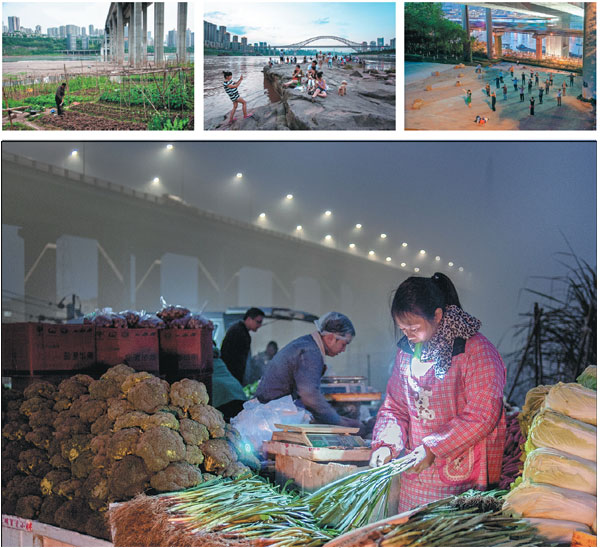Lively lens
By Tan Yingzi (China Daily) Updated: 2017-07-25 07:42Photos of ordinary people near bridges make waves. Tan Yingzi reports in Chongqing.
Chongqing has built more than 4,500 bridges in recent years, the largest number in China.
Located in Southwest China, through which the Jialing River flows into the Yangtze, it is often referred to as the "City of Bridges".
Unlike some photographers who focus on the architectural beauty of bridges, Yin Jun pays attention to the lives of ordinary people around them.
|
A woman (above), with a torch in her mouth, works in a vegetable market under Shuangbei Bridge in Chongqing. The daily lives of ordinary people revolve around the 4,500 bridges in the city. They develop farms, have picnics and dance around the bridges. Photos by Yin Jun / Provided to China Daily |
"Bridges symbolize the development of a city," he says. "They also bring many changes in the lives of people, and I want to record that."
Since 2015, Yin, 54, an amateur photographer, has visited major bridges in downtown from Chongqing and taken more than 20,000 pictures. He lives there as well.
His photo collection, titled Under the Bridges, recently won the top prize at the 2017 Chongqing Photo Contest, which is the largest photography competition in the city held once in two years.
The collection includes eight pictures that show daily life of the local people. Under the bridges, people sell vegetables, have picnics, develop farms, dance, sing, pray and sleep.
The picture of a woman selling vegetables one dimly-lit winter morning with a torch in her mouth has won high praise from the judges and the media.
"It is an open-air Sunday farmer's market under Shuangbei Bridge," Yin says. "There is no lighting system so vendors have to arrange their own lights for the stands when the day is still dark."
He found a young woman as she was busy piling up vegetables with both hands and used her mouth to hold the torch.
"I was touched by her diligence," he recalls. "I got her permission to take the pictures. I also bought some vegetables from her."
Another photo tells the story of an old migrant worker who slept under the Jialingjiang bridge to save money. Many poor people from rural areas in China come to big cities like Chongqing to find jobs.
In 2015, Yin finished his morning swim in the Jialing and found the old man, in his 50s, washing his face by the river. The migrant worker's simple luggage was packed under the bridge.
"Some of my friends knew this man and told me his story," Yin says. "I didn't want to bother him and for six days I tried to find a good angle to take pictures."
The city provides simple accommodation for migrant workers and one night costs about 10 yuan ($1.5), the photographer says, "but the old man thought it was too expensive".
For two years, Yin used his spare time to find such stories, and his friends also gave him tips. He usually went out early mornings or after dinner. His wife often went with him.
Yin began to learn photography in 2012 and in the beginning shot "everything". After a few years, he decided to focus on the daily lives of ordinary people.
"I learned photography by myself," he says. "I have read a lot of books and seen many photo albums."
His favorite photographer was the late US photojournalist Eugene Smith who had contributed to the development of the photo essay format.
"I like his photos of an American county doctor," he says. "I hope I can follow one project for a long time just like him."
Contact the writer at tanyingzi@chinadaily.com.cn
- 'Cooperation is complementary'
- Worldwide manhunt nets 50th fugitive
- China-Japan meet seeks cooperation
- Agency ensuring natural gas supply
- Global manhunt sees China catch its 50th fugitive
- Call for 'Red Boat Spirit' a noble goal, official says
- China 'open to world' of foreign talent
- Free trade studies agreed on as Li meets with Canadian PM Trudeau
- Emojis on austerity rules from top anti-graft authority go viral
- Xi: All aboard internet express












